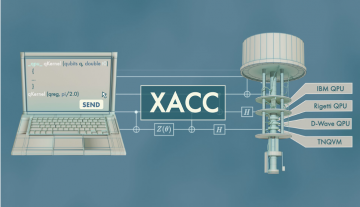
XACC enables the programming of quantum code alongside standard classical code and integrates quantum computers from a number of vendors. This animation illustrates how QPUs complete calculations and return results to the host CPU, a process that could drastically accelerate future scientific simulations. Image courtesy of Michelle Lehman/Oak Ridge National Laboratory, U.S. Dept. of Energy.
In the early 2000s, high-performance computing experts repurposed GPUs — common video game console components used to speed up image rendering and other time-consuming tasks — as co-processors that help CPUs in supercomputers accelerate system operations.
Two decades later, quantum processing units, or QPUs, promise to enhance existing CPU-GPU computer architectures. Future CPU-GPU-QPU supercomputers could tackle complex workloads that would be unmanageable with current systems.